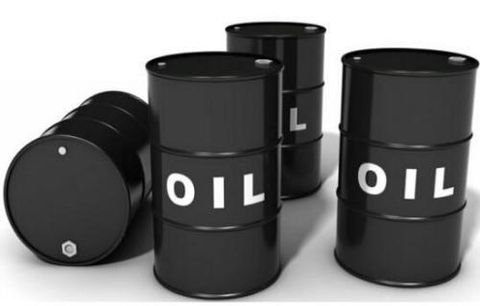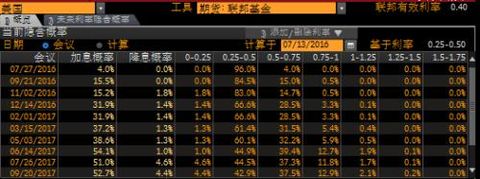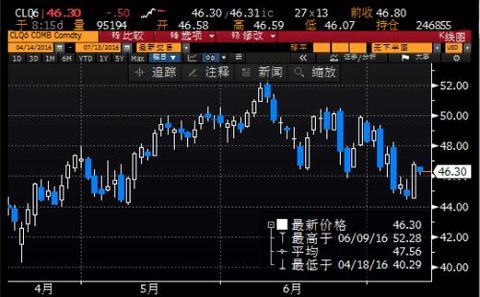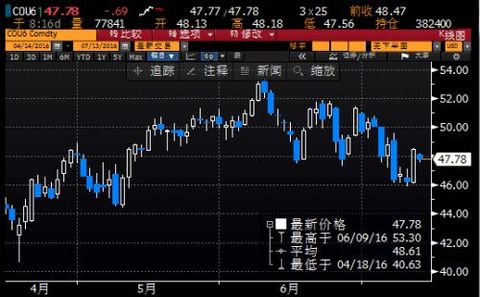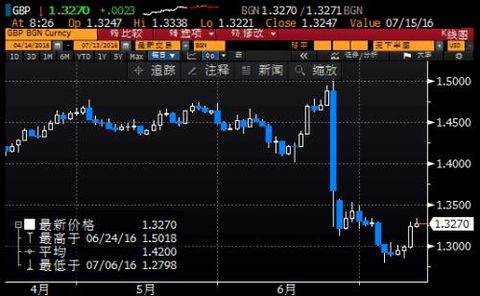On Wednesday (July 13), spot gold rebounded slightly. Earlier, the price of gold fell by more than a week to a low of 1327.41. The overall wording of Fed officials was relative to the hawks. The Fed’s interest rate hike is expected to heat up. The price of gold fell below the multiple moving averages. The rebound in the day may once again encounter short-selling; the crude oil market unexpectedly increased due to API crude oil inventories. The IEA monthly report showed that OPEC output hit an eight-year high, inventory pressure is still high, and the downside risk of oil prices is still relatively large. [Bargain hunting VS rate hike is expected to heat up, gold price rebounded slightly and vigilant short sniper] The cooling of risk aversion caused the price of gold to drop to a low of $1,327 a week in the Asian market. Then investors who bought on dips entered the market to help the gold price rebound, but the gold ETF holdings fell sharply. The Fed’s interest rate hike is expected to be lower than the referendum After the warming up, many Fed officials’ speeches also favored the hawks. The global stock market was also more optimistic this week, and the price of gold may still weaken further this week. (Spot gold daily chart) Tu Guobin, head of research at Yongfeng Financial Group, said that whenever there is short-term pressure, the $1330 range may be the best intervention point for those who are hesitant to pursue high prices. But a trader in Sydney who did not want to be named pointed out that there were some selling at the beginning of the session. It seems that after the price of gold broke $1,330, a little more positions were stopped. Since then the market has been picking up. In the medium and long term, the price of gold will rise, but I will not be surprised if there are more long positions in the market. The price of gold may fall to $1,300 in the next few days. This week, the US S&P 500 index has repeatedly set a record high, and the Dow Jones Industrial Average hit a record high overnight. Asian stock markets approached the 2016 high on Wednesday, due to strong US growth expectations and hopes that major countries will adopt loose economic policies and encourage Investors have previously had a risk appetite for the loss of the British. The safe-haven demand for gold has been significantly weakened, which can be seen from the changes in the position of the gold ETF. Data show that the world's largest gold exchange-traded fund SPDRGOLD Trust's holdings decreased by 16 tons (or 1.63%) on Tuesday (July 12) to 965.22 tons, the largest single-day decline since December 2, 2015. On the other hand, influenced by last week's optimistic non-agricultural employment report, many Fed officials' speeches this week were generally biased towards the hawks. The Fed's interest rate hike is expected to heat up after the Brexit vote, and it is also unfavorable for the gold price. According to US federal funds rate futures, the probability of a Fed rate hike during the year has risen to 31%. (US federal funds rate futures) Federal Reserve Board member and Kansas Federal Reserve Chairman George (EstherGE orge) said on Monday (July 11) that the US non-farm payrolls report was very popular in June, and the Fed has largely achieved the dual responsibility of employment and inflation within its capabilities. The interest rate is too low, "keeping interest rates too low will create risks" and support a gradual rate hike. Fed C's CFO and Cleveland Fed Chairman Loretta Mester pointed out on Tuesday (July 12) that the market's expectation of rising interest rates is reasonable and will follow the path of gradually raising interest rates. When asked about the gorgeous non-agricultural data in June, Mestre said that this is a positive sign that the United States is close to full employment. Federal Reserve Board member and St. Louis Fed President James Bullard said on Tuesday that Brexit will not have a lasting impact on the United States, there is no reason to predict that the United States will fall into recession. Non-agricultural data was strong in June, but employment growth may slow in the future. He still holds the view that the rate hike will be raised in the future. FXStreet Principal Analyst Valeria Bednarik pointed out that as the price of gold fell sharply from the high in 1757.11, the recent gains were buying interest near the low of 1199.51 on May 30 and the 23.6% retracement of last week's high, but technical indicators point to further decline. . [Inventory pressure is re-emerged in the rivers and lakes, and the market still has downside risks after the oil price weakens] International oil prices weakened slightly on Thursday, US crude oil August futures fell more than 1% to 46.28 US dollars / barrel, Brent crude September futures are currently trading at 47.78 US dollars / barrel, the unexpected increase in API crude oil inventories put pressure on oil prices, The IEA monthly report also shows that oversupply still exists, especially because inventory pressures put oil prices at a downside risk. (US crude oil August futures daily chart) (Brent crude oil September futures daily chart) In the early morning, API crude oil inventories recorded an increase again three weeks later, which made the market worry about rising heat. Data show that the American Petroleum Institute (API) issued oil inventory data showed that US crude oil inventories unexpectedly rose by 2.2 million barrels to 523.1 million barrels in the week of July 8, after the market expected to reduce 3 million barrels. The previous three weeks of API crude oil inventories recorded a decrease, and the unexpected increase in inventory data caused the market to worry that oversupply would re-cover the market. "New debt king" Gundlach pointed out that oil prices are likely to fall due to rising stocks, and oil prices are stuck in the range of 40-50 US dollars / barrel. The market is still waiting for official crude oil inventory data. At 22:30 in the evening, the US Energy Agency (EIA) will release crude oil inventory data for the week of July 8. The market is expected to reduce 2.95 million barrels. Investors need to focus on it. In general, most of the EIA inventory will change in the same direction as the API crude oil inventory data, which is unexpectedly expected to increase EIA crude oil inventories, which may weigh on oil prices. In addition, the International Energy Agency (IEA) released a monthly report on Wednesday that despite strong oil demand growth, but OPEC oil output rose (reaching an eight-year high), even if the output of non-OPEC member countries fell sharply, but still make the global oil surplus The phenomenon is stubborn and does not retreat, which constitutes a major depressing of crude oil prices. According to the IEA, OPEC (including Gabon) oil output increased to 33.21 million barrels per day in June, an increase of 510,000 barrels per day, affected by Saudi Arabia and Gabon - Saudi Arabia's June crude oil production was 10.45 million barrels per day (close to The historical high point and Gabon became the 14th member of OPEC, making OPEC oil output hit an eight-year high. The IEA also said that although oil inventories are close to the limit, such a high scale is still a major factor in suppressing oil prices; although the oil market equilibrium is coming, extremely high inventories still pose a threat to oil price stability. Technically, although the US oil has recovered the 5-day moving average, there are still many averages on the top. The pressure on the Bollinger Band's mid-rail resistance is around $48.05. On the whole, the bears still have the upper hand, and the below focus on the 5-day moving average. Support near $45.56/barrel. [Pound hit one-week high after a slight decline, the Bank of England concerned about the resolution] On Wednesday, the pound rallied against the US dollar, once refreshing a one-week high to 1.3340. After Teresa May confirmed it as the new British prime minister, the cooling of political risks continued to provide support for the pound, and the recent surge also caused more Short-covering, and the current market is still concerned about the Bank of England resolution on Thursday (July 14), but from a technical point of view, the pound still has some room for rebound. (Pound Sterling against the US dollar daily chart) Citibank pointed out that the pound against the US dollar was so high that the exchange rate once returned to the 1.33 mark, the market generally believes that this is the result of the early short-covering; investors are waiting for the Bank of England's resolution on Thursday, the current market believes that the Bank of England will be on Thursday The rate cut at the meeting, most expected to cut interest rates by 25 basis points; and with the early short-covering basically completed, the resolution may provide investors with the opportunity to short again. Thu Lan Nguyen, a foreign exchange strategist at Commerz BANK, said that it is still unclear whether the UK can maintain free entry and exit into the EU's single market, so the chances of a poundback are not low. In the case of continuing uncertainty, the UK's huge current account deficit is quite worrying. Another trader pointed out that as more sterling shorts were replenished, the pound against the dollar tied the previous week's high of 1.3340 in the Asian session. If the pound can rise above 1.3350 against the dollar, it may trigger further short covering. 1.3350 is the July 1 high. FXStreet analyst Haresh Menghani said that the pound against the US dollar rebounded from 100% of the decline from June 2015 to February 2016, and now hits the 23.6% retracement after the Brexit decline, close to 1.3350. , constitutes short-term resistance. If the effective breakthrough will open the door to the 1.3475-80 level in the short-term, the exchange rate will break through the 1.350 test 38.2% retrace level 1.3640 area. JP Morgan believes that the pound against the dollar needs to rise above the 1.3500 mark to prove that there will be a bigger rebound in the short-term. more than 10 Years manufacture experience,Quality and delivery time guaranteed,Price and Service Supplied
Polyester twisted rope is highly resistant to ultra-violet rays, stays flexible and does not shrink or harden,does not float .Low stretch, abrasion resistant. Spliceable. Resists chemicals.
P.E. rope is at widely used of the synthetic ropes. It is resistant to acids, oils, grease, gasoline and most chemicals, and it is designed to be tough. We gather the R&D, production and international trade all-in-one and become a comprehensive enterprise group.High Quality 3 Strand rope.
Braided Safety Strands Rope,Rope Used In Marine,3 Strand Mooring Rope,High Tensile Rope Yangzhou YILIYUAN Rope & Net Factory , https://www.knsmy.com